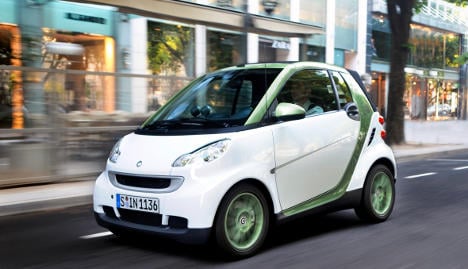It’s taken twelve years for the world to catch up with Daimler’s tiny Smart car.
When the Stuttgart-based carmaker behind luxury brand Mercedes launched its tiny two-seater back in 1998, no-one was seriously discussing ditching petroleum-powered vehicles for ones with more environmentally friendly electrical propulsion.
But the soaring price of oil and the threat of climate change mean the now ubiquitous Smart Fortwo will soon be available as it was originally envisioned – with a battery instead of a fuel tank.
“The Smart should have been born electric. That’s its true nature,” said Marc Langenbrinck, Smart’s managing director, said when he introduced the latest incarnation of its Fortwo model last week in Berlin.
But Langenbrinck and his colleagues in Germany’s car industry realise they’ll need a lot of help to make the historic shift from the combustion engine to automobiles running solely on electricity. Aside from the huge investments in infrastructure needed to make the widespread use of electric autos a reality, people will need to rethink urban living and mobility.
Click here for a photo gallery of the new e-Smart.
Accordingly, Smart has decided to couple the marketing the introduction of the electric Fortwo in 2012 with a multidisciplinary roving discussion. Over the next year, the “Smart Urban Stage” will roll through Berlin, Rome, Zurich, Paris, Madrid and London looking for answers to the questions facing the “City of the Future.”
The carmaker has also commissioned exhibitions exploring the topics of mobility, design, technology, architecture, science and society with the aim of promoting creative solutions to city living.
“It’s all about optimising urban landscapes with sustainability in mind,” said Langenbrinck. “We want to spark something here.”
To encourage creativity, Smart will award the person with the best idea in each city a €10,000 prize. The overall European winner will win their very own electric Fortwo.
In Berlin, the Smart Urban Stage will feature everything from practical suggestions like urban gardening to whimsical conceptual musings about robotic “harvesters” that would gather up a city’s wasted energy.
Hermann Weizenegger, a professor at Potsdam’s University of Applied Sciences and curator of the exhibition’s design section, welcomed Smart’s inclusive approach to promote its new electric car.
“It’s great to see more support for such pilot projects,” he told The Local. “Companies often just plop a product down in front of consumers. But this type of discussion ideally means the product ends up more closely matching the needs of society.”
Facing the reality that purchasing an electric car is likely to put philosophical principles ahead of economics for years to come, it’s certainly a more nuanced approach than simply rolling the e-Smart into showrooms and expecting people to line up to buy them.
And since many people have never been behind the wheel of an electric car, Smart is also giving the public a chance to drive the new Fortwo at each stop the Urban Stage makes across Europe.
Smart driving
The Local managed to get its hands on a spanking new e-Smart convertible for a quick spin around Berlin’s Mitte district on a recent sunny spring day, and the overall experience was an enjoyable one.
In fact, for short urban trips, there’s no compelling argument against the electric Smart from the driving perspective. Accelerating from 0-60 km/h in just 6.5 seconds, it’s as zippy and responsive as its gasoline-powered cousin. And given it can be driven 130 kilometres before needing a charge from a normal household socket, the e-Smart will have a range suitable for the vast majority of city dwellers.
Granted, the car’s gauges on the dash are bit gimmicky – why, for instance, do you need to see the needles bouncing back and forth as you drain the battery by accelerating and replenishing it while braking?
But otherwise the 30-kilowatt electric motor offers a satisfying boost when the pedal is put to the metal. For those not familiar with the torque offered by electric drive, the experience can best be described as gunning a bumper car at the county fair. However, while the throttle on the electric vehicles used for dodgem carnival rides quickly cuts out so you don’t flatten the seven-year-old in front of you, the e-Smart will keep accelerating up to 100 km/h.
This is fun, but poses a potential hazard for pedestrians not accustomed to the near-silent running of electric cars. Until cities are filled with the significantly quieter vehicles, the transition phase could be challenging for both hard-of-hearing grannies and e-car drivers.
Langenbrinck would not be drawn on how much the e-Smart will cost when it goes on sale in 2012, but he said Daimler would ensure it was “affordable” for average folks and not just rich, urban tree-huggers.
But you might not have to buy one if Smart’s successful car-sharing project is expanded from the southern German city of Ulm and Austin, Texas.
The innovative scheme lets registered users hop into any e-Smart they find scattered around the city and drive them for as long as they like without worrying about special parking spots or membership costs. Modelled on popular bike-sharing programmes, it also eliminates the issue of recharging because there are maintenance teams to make sure the cars always have enough juice.
Such pilot projects could certainly help increase the acceptance of electric cars in German cities, and one day might even help Daimler make its luxury Mercedes saloons fully electric alongside the tiny Smart.
The Smart Urban Stage exhibition is open to the public as are free test drives of the Smart electric drive model from May 8 to June 13 in Berlin at Oranienburger Straße 59-63.



 Please whitelist us to continue reading.
Please whitelist us to continue reading.
Member comments